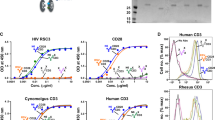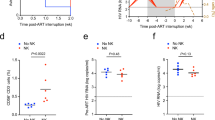Abstract
Intrakines, modified intracellular chemokines, offer a novel strategy to prevent cellular entry of HIV-1 by blocking the surface expression of HIV-1 co-receptors. To investigate potential clinical applications of the RANTES-intrakine, we explored the use of HIV-1-based lentiviral vectors for therapeutic gene transfer into T-lymphocytes. RANTES-intrakine genes can be efficiently transduced into primary human T-lymphocytes by lentiviral vectors, especially when human T-lymphocytes were stimulated with CD3 and CD28 antibodies. The transduced T cells showed decreased surface expression of the chemokine receptor CCR-5, as well as CCR-1 and CCR-3. This lentivirus-mediated approach to intrakine gene transfer protected human T-lymphocytes from infection by a variety of R5-tropic HIV-1 strains. A quantitative real-time PCR assay, developed to monitor cells for HIV entry and persistence, revealed persistent low copy numbers of proviral HIV DNA in RANTES intrakine-transduced T-lymphocytes during 3-week culture, suggesting that viruses produced from infected untransduced cell populations were unable to infect the surrounding transduced T-lymphocytes. We conclude that targeting HIV-1 co-receptors to block virus entry with lentiviral vectors is an attractive approach to the control of HIV-1 infection.
This is a preview of subscription content, access via your institution
Access options
Subscribe to this journal
Receive 12 print issues and online access
$259.00 per year
only $21.58 per issue
Buy this article
- Purchase on Springer Link
- Instant access to full article PDF
Prices may be subject to local taxes which are calculated during checkout







Similar content being viewed by others
References
D'Souza MP, Harden VA . Chemokines and HIV-1 second receptors. Confluence of two fields generates optimism in AIDS research Nat Med 1996 2: 1293–1300
Cairns JS, D'Souza MP . Chemokines and HIV-1 second receptors: the therapeutic connection Nat Med 1998 4: 563–568
Deng H et al. Identification of a major co-receptor for primary isolates of HIV-1 Nature 1996 381: 661–666
Choe H et al. The beta-chemokine receptors CCR3 and CCR5 facilitate infection by primary HIV-1 isolates Cell 1996 85: 1135–1148
Alkhatib G et al. CC CKR5: a RANTES, MIP-1alpha, MIP-1beta receptor as a fusion cofactor for macrophage-tropic HIV-1 Science 1996 272: 1955–1958
Doranz BJ et al. A dual-tropic primary HIV-1 isolate that uses fusin and the beta-chemokine receptors CKR-5, CKR-3 and CKR-2b as fusion cofactors Cell 1996 85: 1149–1158
Dragic T et al. HIV-1 entry into CD4+ cells is mediated by the chemokine receptor CC-CKR-5 Nature 1996 381: 667–673
Clapham PR et al. HIV coreceptors, cell tropism and inhibition by chemokine receptor ligands Mol Memb Biol 1999 16: 49–55
Liu R et al. Homozygous defect in HIV-1 coreceptor accounts for resistance of some multiply-exposed individuals to HIV-1 infection Cell 1996 86: 367–377
Dean M et al. Genetic restriction of HIV-1 infection and progression to AIDS by a deletion allele of the CKR5 structural gene. Hemophilia Growth and Development Study, Multicenter AIDS Cohort Study, Multicenter Hemophilia Cohort Study, San Francisco City Cohort, ALIVE Study (published erratum appears in Science 1996; 274: 1069) Science 1996 273: 1856–1862
Samson M et al. Resistance to HIV-1 infection in Caucasian individuals bearing mutant alleles of the CCR-5 chemokine receptor gene Nature 1996 382: 722–725
Huang Y et al. The role of a mutant CCR5 allele in HIV-1 transmission and disease progression Nat Med 1996 2: 1240–1243
Zimmerman PA et al. Inherited resistance to HIV-1 conferred by an inactivating mutation in CC chemokine receptor 5: studies in populations with contrasting clinical phenotypes, defined racial background, and quantified risk Mol Med 1997 3: 23–36
Michael NL et al. The role of viral phenotype and CCR-5 gene defects in HIV-1 transmission and disease progression Nat Med 1997 3: 338–340
Yang AG et al. Phenotypic knockout of HIV type 1 chemokine coreceptor CCR-5 by intrakines as potential therapeutic approach for HIV-1 infection Proc Natl Acad Sci USA 1997 94: 11567–11572
Yang AG et al. Anti-HIV type 1 activity of wild-type and functional defective RANTES intrakine in primary human lymphocytes Hum Gene Ther 1998 9: 2005–2018
Sirven A et al. The human immunodeficiency virus type-1 central DNA flap is a crucial determinant for lentiviral vector nuclear import and gene transduction of human hematopoietic stem cells Blood 2000 96: 4103–4110
Salmon P et al. High-level transgene expression in human hematopoietic progenitors and differentiated blood lineages after transduction with improved lentiviral vectors Blood 2000 96: 3392–3398
Naldini L et al. In vivo gene delivery and stable transduction of nondividing cells by a lentiviral vector Science 1996 272: 263–267
Schroers R et al. Transduction of human PBMC-derived dendritic cells and macrophages by an HIV-1-based lentiviral vector system Mol Ther 2000 1: 171–179
Sirven A et al. Enhanced transgene expression in cord blood CD34(+)-derived hematopoietic cells, including developing T cells and NOD/SCID mouse repopulating cells, following transduction with modified trip lentiviral vectors Mol Ther 2001 3: 438–448
Baggiolini M, Dewald B, Moser B . Interleukin-8 and related chemotactic cytokines – CXC and CC chemokines Adv Immunol 1994 55: 97–179
Rollins BJ . Chemokines Blood 1997 90: 909–928
Schall TJ . Biology of the RANTES/SIS cytokine family Cytokine 1991 3: 165–183
Levine BL . Antiviral effect and ex vivo CD4+ T cell proliferation in HIV-positive patients as a result of CD28 costimulation Science 1996 272: 1939–1943
Finer MH et al. cKat: a high-efficiency retroviral transduction system for primary human T lymphocytes Blood 1994 83: 43–50
Jabs WJ et al. Normalized quantification by real-time PCR of Epstein-Barr virus load in patients at risk for posttransplant lymphoproliferative disorders J Clin Microbiol 2001 39: 564–569
Perrin L, Telenti A . HIV treatment failure: testing for HIV resistance in clinical practice Science 1998 280: 1871–1873
Richman DD . How drug resistance arises Sci Am 1998 279: 88
Tozser J . HIV inhibitors: problems and reality Ann NY Acad Sci 2001 946: 145–159
Woffendin C et al. Nonviral and viral delivery of a human immunodeficiency virus protective gene into primary human T cells Proc Natl Acad Sci USA 1994 91: 11581–11585
Morgan RA, Walker R . Gene therapy for AIDS using retroviral mediated gene transfer to deliver HIV-1 antisense TAR and transdominant Rev protein genes to syngeneic lymphocytes in HIV-1 infected identical twins Hum Gene Ther 1996 7: 1281–1306
Mitsuyasu RT et al. Prolonged survival and tissue trafficking following adoptive transfer of CD4zeta gene-modified autologous CD4(+) and CD8(+) T cells in human immunodeficiency virus-infected subjects Blood 2000 96: 785–793
Klimatcheva E et al. Defective lentiviral vectors are efficiently trafficked by HIV-1 and inhibit its replication Mol Ther 2001 3: 928–939
Mautino MR, Keiser N, Morgan RA . Inhibition of human immunodeficiency virus type 1 (HIV-1) replication by HIV-1-based lentivirus vectors expressing transdominant Rev J Virol 2001 75: 3590–3599
Podsakoff GM . Lentiviral vectors approach the clinic but fall back: National Institutes of Health Recombinant DNA Advisory Committee review of a first clinical protocol for use of a lentiviral vector Mol Ther 2001 4: 282–283
Michael NL, Moore JP . HIV-1 entry inhibitors: evading the issue Nat Med 1999 5: 740–742
Schols D et al. Inhibition of T-tropic HIV strains by selective antagonization of the chemokine receptor CXCR4 J Exp Med 1997 186: 1383–1388
Murakami T et al. A small molecule CXCR4 inhibitor that blocks T cell line-tropic HIV-1 infection J Exp Med 1997 186: 1389–1393
Doranz BJ et al. A small-molecule inhibitor directed against the chemokine receptor CXCR4 prevents its use as an HIV-1 coreceptor J Exp Med 1997 186: 1395–1400
Donzella GA et al. AMD3100, a small molecule inhibitor of HIV-1 entry via the CXCR4 co-receptor Nat Med 1998 4: 72–77
Dardalhon V et al. Lentivirus-mediated gene transfer in primary T cells is enhanced by a central DNA flap Gene Therapy 2001 8: 190–198
Bai X et al. Genetic co-inactivation of macrophage- and T-tropic HIV-1 chemokine coreceptors CCR-5 and CXCR-4 by intrakines Gene Therapy 1998 5: 984–994
Desire N et al. Quantification of human immunodeficiency virus type 1 proviral load by a taqman real-time pcr assay J Clin Microbiol 2001 39: 1303–1310
Acknowledgements
We thank Mike Cubbage for technical assistance with the MoFlo cell sorting. Also we wish to thank D Trono (University of Geneva) and P Charneaux (Institut Pasteur, Paris) for providing plasmid vectors. We would like to thank Malcolm K Brenner for critical review of the manuscript. This work was supported by a NIH grant R01-AI48480 (S-Y Chen). R Schroers and H-J Wagner were in part supported by the Deutsche Forschungsgemeinschaft (DFG, Schr 629/1-1, Wa 1149/2-1). CM Davis was in part supported by a NIH fellowship.
Author information
Authors and Affiliations
Rights and permissions
About this article
Cite this article
Schroers, R., Davis, C., Wagner, HJ. et al. Lentiviral transduction of human T-lymphocytes with a RANTES intrakine inhibits human immunodeficiency virus type 1 infection. Gene Ther 9, 889–897 (2002). https://doi.org/10.1038/sj.gt.3301711
Received:
Accepted:
Published:
Issue Date:
DOI: https://doi.org/10.1038/sj.gt.3301711
Keywords
This article is cited by
-
Lentiviral delivery of combinatorial CAR/CRISPRi circuit into human primary T cells is enhanced by TBK1/IKKɛ complex inhibitor BX795
Journal of Translational Medicine (2020)
-
Gene transfer of two entry inhibitors protects CD4+ T cell from HIV-1 infection in humanized mice
Gene Therapy (2016)
-
Epigenetic Regulation of Antibody Responses by the Histone H2A Deubiquitinase MYSM1
Scientific Reports (2015)
-
Cell-based gene therapy against HIV
Gene Therapy (2015)
-
Problems and Prospects of Gene Therapy Against HIV
Pharmaceutical Chemistry Journal (2014)



